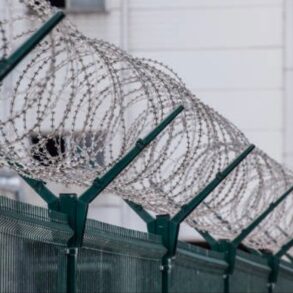Filed
7:20 p.m. EST
02.21.2025
A small change in a judge’s order appears to have led the Trump administration to start arrangements to transfer more than a dozen transgender women.
The entrance to FMC Carswell in Fort Worth, Texas.
In 2022, after years of legal battles, Donna Langan became the first federal prisoner ever to receive gender confirmation surgery. Her listing in the Bureau of Prisons directory says “female.” Yet earlier this week, she was notified that the federal prison system was moving her to a men’s facility.
For Langan, who has been incarcerated since 2016 at FMC-Carswell, a women’s prison in Texas, word of her imminent transfer was terrifying, said her attorney Moira Meltzer-Cohen. “In the case of women being told that they are to be sent to a facility full of men, anybody would be reasonably in fear for their lives,” Meltzer-Cohen said.
According to several sources familiar with the situation, more than a dozen other transgender women in federal prisons received word this week that they, too, would be moved to men’s facilities.
Last month, President Trump issued an executive order that, among other provisions, barred trans women from being housed in women’s prisons. After three trans prisoners sued, arguing that the order was discriminatory and cruel and unusual punishment, a judge prevented them from being moved, but the Bureau began making arrangements to transfer other transgender prisoners.
Iris Soliman’s daughter is one of the transgender women who learned she was slated to be moved to a men’s prison. “I’m worried about what’s going to happen to her,” Soliman said. “It’s humiliating. It’s devastating. They would destroy her. She’s really beautiful. She doesn’t look anything like a man … I’m sure she’ll be raped.”
According to an internal list obtained by The Marshall Project, the Bureau of Prisons has housed 22 transgender women in federal women’s prisons and one transgender man in a men’s prison — fewer than 0.02% of federal prisoners. Yet this tiny group of people has been the subject of intense focus from Department of Justice officials since President Trump took office, according to several people familiar with discussions at the Bureau of Prisons.
Trump’s executive order, titled “Defending Women from Gender Ideology Extremism and Restoring Biological Truth to the Federal Government,” directed federal officials to ensure that “males are not detained in women’s prisons” and that federal funds are not used for prisoners’ gender-confirming medical treatments. The fallout from that order has been chaos and confusion across the federal prison system, as wardens and other regional and local officials attempted to follow the order without any clear guidance from Washington. (Federal officials released guidance on Friday.)
Several transgender women sued the officials tasked with enforcing the order, and on Feb. 4, U.S. District Judge Royce Lamberth ordered the prison system not to enforce the relevant sections of the executive order temporarily while the lawsuit proceeded.
A few women who had been moved to men’s prisons were moved back.
Then, on Tuesday afternoon, Lamberth issued an order making his earlier ruling more permanent. It did not differ in substance from his earlier order, but added a few crucial words: He said prison officials were prevented from implementing the executive order “against plaintiffs.”
Since there were only three plaintiffs, Trump administration officials appear to have seized on this small change to begin making arrangements to transfer all the remaining transgender women housed in women’s prisons to men’s prisons — even those, like Donna Langan, who have already had gender confirmation surgery.
Hours after Lamberth issued his order on Tuesday, a Trump appointee in the Department of Justice spoke with a top Bureau of Prisons official, according to an email the official sent to his staff, and “said to start the process of designating and moving inmates in institutions that don’t match their biological sex to institutions that are consistent with their biological sex.” Except for the handful of women whom a judge had specifically identified, “there are no exceptions.”
The Bureau of Prisons did not respond to an emailed list of questions. Neither did officials at four of the federal women’s prisons that house transgender women. An official at FCI Aliceville, a women’s prison in Alabama that currently houses two transgender women, wrote in an unsigned email that they wouldn’t comment on the transfer status of any single person, but that the federal prison agency “supports and will comply with all executive orders issued by the President of the United States.”
Transgender people in prison are exceptionally vulnerable to abuse and assault. In one federal study, 37% of incarcerated transgender people reported having been sexually assaulted in prison, versus 3% of everyone else behind bars.
“Being a transgender inmate is going to put them at risk,” said a correctional staffer who is familiar with the women’s prison in Fort Worth, Texas, where Langan and 10 other transgender women are currently housed. The staffer confirmed that most of the transgender prisoners are slated for transfer to men’s prisons.
“It’s probably going to cause problems among the other inmate population,” said the staffer, who asked not to be named because he feared retaliation for speaking about this issue. “Probably they’ll be fighting to get close to this individual. That’s the closest thing they’ve seen to a woman in a long time. So they’re going to be extra aggressive with each other, too.”
Transgender women are moved to a women’s prison only after undergoing a lengthy process overseen by a panel of experts at the Bureau of Prisons called the Transgender Executive Council — which has since been renamed to remove the word “transgender.” The Council was so reluctant to move people that in at least one case, a federal judge said he was concerned they might be making excuses to deny a transgender woman a transfer to a women’s facility.
“These decisions were never made lightly,” said Alix McLearen, who oversaw the Council before her retirement last year. “We usually required at least one year of clear conduct, program participation, hormones. No decision about housing was ever made without considering the safety of the staff and all the people in prison.” McLearen retired from the bureau last year.
The federal prison system has been plagued by violence and short staffing in recent years. The system is now also being asked to house thousands of ICE detainees as the Trump administration ramps up its immigration enforcement efforts.
Late Friday, attorneys representing transgender women in federal prison filed updated documents in federal court, seeking to add nine additional plaintiffs to the case. But according to Amy Whelan, an attorney with the National Center for Lesbian Rights, unless a judge specifically prohibits officials from moving them, they’re still at risk of being moved.
This post was originally published on this site be sure to check out more of their content.








